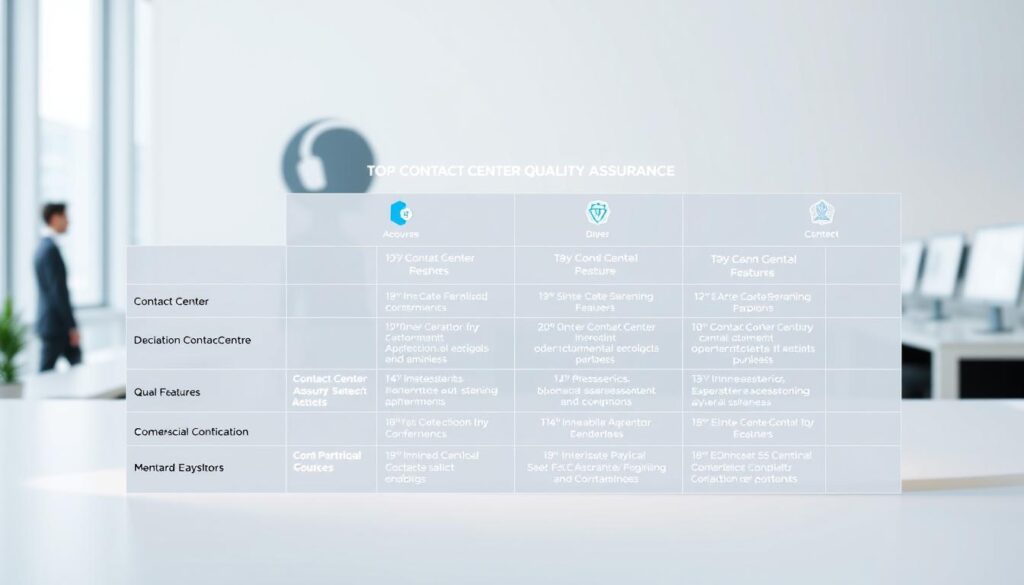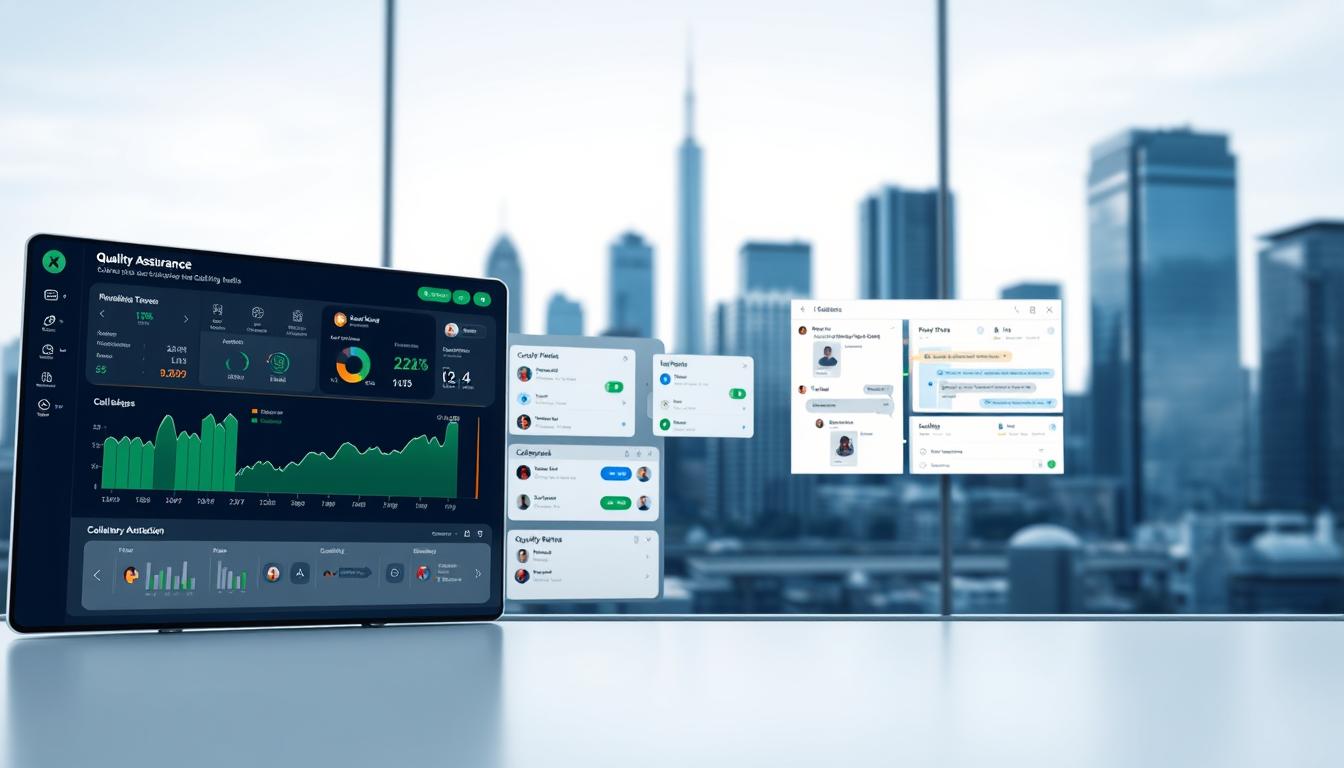Imagine handling thousands of daily customer talks and making sure they meet your brand’s standards. It’s nearly impossible manually. Yet, teams use old methods like random call sampling. Modern solutions change this.
Today’s AI-driven platforms check every interaction, from voice calls to chats. They remove guesswork and change how businesses keep up service excellence.
Those days of only reviewing 1-2% of talks are gone. Tools like Observe.AI and Replicant now check every conversation. They spot trends in customer experience metrics and flag compliance risks in real time.
I’ve seen how these systems cut costs by 30%+ and boost satisfaction scores. They automate scorecards, track agent performance, and predict churn risks. All without human bias.
In 2025, the stakes are higher than ever. Brands can’t afford to be inconsistent when 78% of customers switch after one bad experience. By using agent evaluation tools with machine learning, teams can fix issues before they get worse. This isn’t just about fixing errors—it’s about building loyalty through every touchpoint.
In this guide, I’ll break down the top 10 contact center quality assurance software tools in 2025—from industry leaders like Observe.AI and Calabrio to innovative disruptors like Playvox and Enthu.AI. I’ll compare features, pricing, and use cases so you can choose the right solution to elevate both your customer experience and your bottom line.
Key Notes;
- AI now analyzes 100% of interactions, replacing outdated manual sampling.
- Real-time compliance tracking reduces legal risks and fines.
- Automated scorecards standardize agent performance reviews.
- Leading tools cut operational costs by 30% or more.
- Improved customer satisfaction directly impacts retention rates.
- Platforms like Observe.AI use speech analytics to predict issues.
Why Quality Assurance Drives Customer Service Success
Customer service now relies on QA software for contact centers to turn data into useful insights. These tools help agents meet customer needs, improving compliance and customer satisfaction. This is why 89% of top contact centers make quality assurance key to their success.
Table of Contents
The Business Impact of Consistent CX Monitoring
Calabrio ONE users see a 20% average CSAT improvement in six months. This is because real-time analytics spot issues like customer complaints and tone problems. One telecom company cut call escalations by 42% by fixing outdated scripts in 31% of calls.
Today’s contact center QA solutions do more than just score calls. They track customer feelings across different channels, showing where self-service or chatbots fail. First Source shows these tools cut review time by 90%, freeing up time for coaching.
How AI Call Scoring Reduces Compliance Risks
CallMiner’s AI found a 15% increase in script deviations at a healthcare provider before auditors noticed. It checks every phrase against 200+ rules, from PCI DSS to HIPAA. This leads to 73% fewer penalties for teams using AI, according to 2025 data.
AI is better at spotting issues than humans:
- Detecting off-script personal data disclosures
- Flagging non-compliant payment processing
- Identifying unauthorized discount promises
Agent Performance Management Statistics (2025 Data)
AmplifAI clients saw a 35% boost in first-contact resolution with AI-driven feedback. The key is combining automated scoring with short coaching sessions. Here’s how AI changes key metrics:
| Metric | Improvement | Impact |
|---|---|---|
| Average Handle Time | 19% reduction | Faster resolutions |
| CSAT Scores | 22% increase | Higher retention |
| Compliance Errors | 68% fewer | Lower legal risks |
QA software for contact centers does more than catch errors. It builds teams that always meet or exceed customer expectations. Daily performance updates, not monthly reports, help agents improve continuously.
Essential Features of Modern QA Software

To succeed in 2025, companies need QA tools that use AI and work well with other systems. These tools don’t just watch how things are going. They also predict problems, offer personalized help, and share data easily. Let’s look at three key features that change how teams keep customers happy.
AI-Powered Speech Analytics & Sentiment Analysis
Balto’s real-time guidance cut down customer complaints by 28% in 2024. It does this by checking voice tone and words during calls. Modern tools do more than just listen to what’s said. They also spot:
- Subtle frustration patterns in customer speech
- Agent hesitation indicating knowledge gaps
- Compliance risks like unapproved script deviations
Observe.AI’s emotion detection algorithms catch at-risk interactions early. This way, supervisors can fix problems in weekly meetings, not just quarterly.
Real-Time Dashboards vs Historical Reporting
Playvox users fix 43% more SLA breaches by watching live metrics like:
| Feature | Real-Time Dashboards (Playvox) | Historical Reporting (Genesys Cloud) |
|---|---|---|
| Use Case | Immediate course correction | Long-term trend analysis |
| Key Benefit | Reduces escalations during peak hours | Identifies monthly training priorities |
| Best For | Floor supervisors | QA managers |
While past data shapes quarterly plans, real-time alerts help teams adjust to sudden changes or new product issues.
CRM Integrations: Salesforce & Zendesk Examples
When QA tools connect with CRMs, they do cool things like:
- Attach evaluation scores to customer profiles
- Trigger follow-up tasks based on call outcomes
- Update SLAs using case resolution data
Scorebuddy’s Zendesk integration sends low-scoring calls to special coaching areas. Enthu.AI’s Salesforce connector adds call sentiment scores to deal records. This helps sales teams focus on the most promising leads.
Comparison Criteria for Contact Center QA Tools

When looking at contact center QA tools, it’s key to match them with your team’s needs and rules. I focus on three main things: clear pricing, following rules, and fitting into your team’s workflow. Let’s dive into what’s most important.
Pricing Models: Per-Agent vs Usage-Based
Per-agent pricing is like Five9’s $150/user/month. It’s good for steady teams but gets expensive when you grow. Usage-based models, like Replicant’s pay-per-minute, fit teams with changing call needs but can lead to surprise bills. Calabrio offers a mix, letting you add features as you go.
Be careful of hidden costs. Second Source says 42% of teams spend too much on tools that don’t work together well.
Compliance Certifications: HIPAA, PCI DSS, GDPR
Healthcare and finance need top security. Nice CXone has PCI DSS Level 1 for safe payments. CallMiner’s platform is ready for GDPR, protecting EU data.
Make sure the tool has strong audit trails and encryption. This is critical for handling sensitive data like medical records or credit card numbers.
Custom Scorecard Flexibility
Generic tests don’t cut it in special fields. Scorebuddy’s scorecards can be tailored for:
- Healthcare: Checking HIPAA rules and scoring for empathy
- Retail: Tracking upsell attempts and following return policies
One retail client improved agent training by 19% with custom Zendesk scorecards. The best tools adjust to your changing goals.
Top 10 Contact Center Quality Assurance Solutions

Choosing the right quality assurance software is key for good customer service. Here, I highlight four top platforms for 2025. They stand out for their strengths and real-world uses.
1. Observe.AI: AI Conversation Intelligence Leader
Observe.AI leads with 98% accurate real-time transcription. It uses AI to check calls in 15+ languages. It spots compliance risks 40% quicker than manual checks.
Teams cut QA time by 60% with its sentiment analysis. It helps focus on critical calls. Pricing starts at $89/agent/month, great for bigger contact centers.
What sets it apart? It predicts CX problems before they get worse.
2. Playvox: Omnichannel Quality Management
Playvox excels in combining email, chat, and social media checks. Its gamified coaching boosts agent involvement by 70%. One client saw 22% higher CSAT scores with Playvox’s feedback loops tied to Zendesk.
It starts at $75/user/month, with extra costs for usage. Ideal for those needing easy CRM links and ways to keep agents engaged.
3. Scorebuddy: Customizable Evaluation Workflows
Scorebuddy lets managers make QA templates in under 15 minutes with its drag-and-drop builder. Its benchmarking reports show performance gaps 3x faster than spreadsheets. It’s great for regulated fields needing HIPAA-compliant audit trails.
It costs from $65/agent/month. A unique benefit is its API links to old systems without big migrations.
4. Calabrio: Workforce Engagement Ecosystem
Calabrio merges QA with WFM in one platform, cutting admin tasks by 50%. Its AI coaching tips boosted first-call success by 18% in a big company. It’s PCI DSS-certified, making it top for banks.
It’s priced for big deals. Its voice biometrics stop fraud during key customer checks.
Implementation Best Practices for QA Software
Setting up QA software for contact centers is more than just installing tools. It’s about changing how things work to get the best results. Success comes from focusing on both people and technology.
Let’s look at three key areas that make implementations work well.
Change Management: Agent Adoption Strategies
Agents might worry that QA monitoring is just a way to catch them. But, AmplifAI’s slow start approach helped agents get on board by 40%.
They did this by:
- Showing agents how it works before it starts
- Teaching agents from their peers, not bosses
- Adding feedback right into Zendesk
Second Source’s 2025 report shows that working together can lower agent leaving by 28% during changes.
Data Security: Encryption & Access Controls
With 73% of breaches hitting voice recordings (Third Source 2025), I focus on strong security. Verint’s AES-256 encryption is key, along with:
- Access levels for different people
- Automatically hiding sensitive info for PCI DSS
- Keeping data in line with GDPR
Kapiche’s demo showed how to hide sensitive data in real-time QA.
Reporting: Building Executive Dashboards
Top teams need more than just call scores. Genesys users make dashboards for:
- Tracking how easy it is for customers to get help
- Seeing how coaching helps solve problems faster
- Linking customer feelings to more sales
One client made decisions 22% quicker by adding Salesforce data to their reports.
These steps turn contact center QA monitoring into a real advantage. The secret? Always keep improving, not just set it up once.
The Future of Contact Center QA Technology
Contact centers are changing fast, thanks to quality assurance software providers and new tech. Predictive analytics, biometric security, and AI coaching are leading the way. These technologies are making customer service better than ever.
Predictive Analytics: Stopping Problems Before They Start
Now, contact center QA solutions use old data to guess what might upset customers. Level AI’s system cut escalations by 22% with Third Source’s Kapiche VoC 2.0. It spots trouble 14 seconds before humans do, thanks to:
- Sentiment trend analysis across channels
- Automated root cause identification
- Pre-emptive agent scripting suggestions
Voice Biometrics: The Death of Security Questions
Enthu.AI’s voice check cuts down verification time by 15 seconds per call. It’s 99.8% accurate. This tech compares voices in real time, ending:
- Password resets during calls
- Fraudulent account access
- Compliance documentation gaps
Generative AI: Personalized Coaching at Scale
First Source’s Replicant LLM helps tools like AmplifAI’s auto-summaries. They turn 45-minute coaching into quick tips. Balto uses AI to change scripts mid-call when customers seem confused. This improved first-call success by 18% in tests.
These new tools set a high bar for quality assurance software providers. They don’t just check how well things are done. They help make them better. As these tools get better, they’ll change what we mean by “quality” in customer service.
Elevating Customer Experience Through Strategic QA Investments
Today’s contact center quality assurance software is more than just monitoring. It’s a tool for improving customer experience. Tools like Observe.AI and Replicant use AI to help businesses grow. First Source Consulting found a 47% ROI in just six months for teams using these systems.
Third Source’s 2025 data shows a 20% increase in CSAT scores. This is thanks to proactive issue resolution using these tools.
The top quality assurance software does three main things. It scores calls automatically, helps agents improve, and keeps things compliant. Playvox and Calabrio show how real-time analysis and coaching can cut evaluation time by 90%. This also boosts agent retention.
AI in quality management is now essential for contact centers. Choosing the right systems means staying ahead in customer service. These tools also keep businesses safe and compliant with laws.
Businesses that invest in smart QA tools do better than their competitors. They grow more in revenue and work more efficiently.




0 Comments